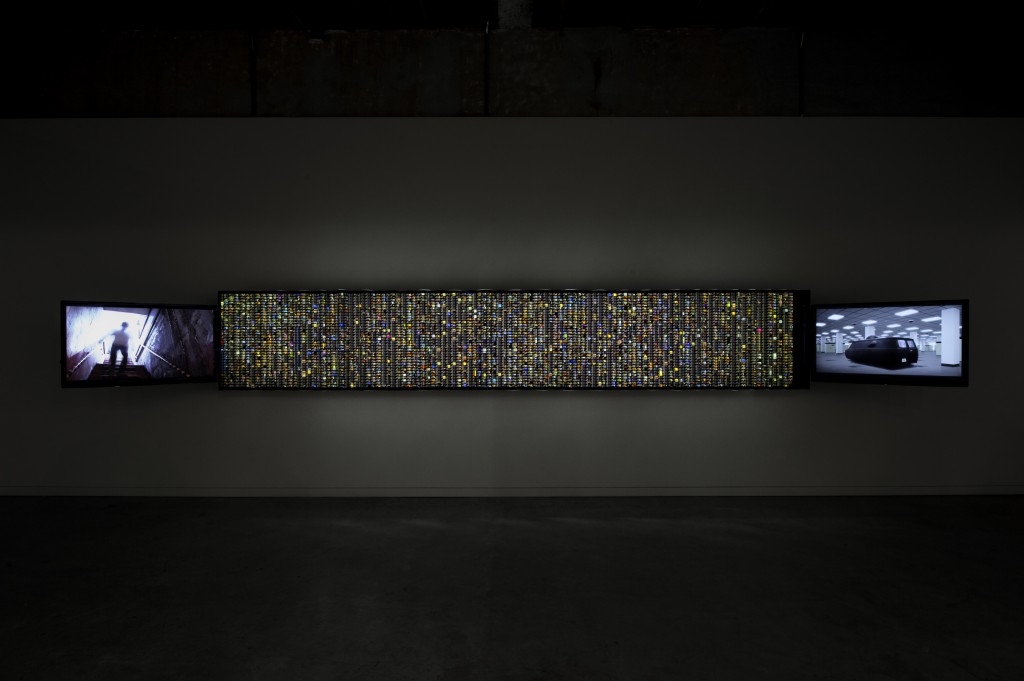Co-location Dream – Computer.m4v
Time Capsule Triptych
Collaboration with Chip Lord and Curtis Schreier
Essay by Courtney Fink
2008, in the depths of NIKE Missile Site SF-88 in the Marin Headlands, members of the seminal collective Ant Farm unearthed their 1971 Media Van. Reportedly, a Golden Gate National Recreation Area ranger led them deep into the bomb-proof base, where they discovered the van—lost since 1972. The van’s mysterious location led them to speculate that perhaps it was intended as a time capsule, and they began the van’s transformation into Media Van v.08 (Time Capsule).
The original Media Van was the mobile documentation and presentation tool that was the home of Ant Farm’s 1971 cross-country Truckstop Tour of university lectures and workshops. It was the basis for a series of nomadic projects, and it enabled the creation of videos recording these demonstrations. In its original mode, the van had a bubble turret for videotaping and was equipped with a Sony video PortaPack, a mobile TV studio, a trailer, and an inflatable solar-heated shower unit. Through the van, Ant Farm brought an interest in high technology to the nomadic counterculture.
Over the last year Ant Farm has rebuilt the van; it now includes a media hookah (HUQQUH), a technological base from which the van [CF1] can acquire and store contemporary digital media content for the future. The vehicle includes much of the same functionality as the original Media Van but reflects the technology of our time. In 2008 members of Ant Farm used the van to collect data, and the HUQQUH contains more than 4,000 randomly downloaded pictures and music files selected from personal mobile devices. This excess of information is an effective cultural record of a time because it presents an unbiased snapshot that excludes nothing.
At Southern Exposure, Ant Farm presents Time Capsule Triptych, a project that includes a video of the van’s emergence and renovation, the entire contents of the media HUQQUH, and information about the current storage location of the van (slated to be unearthed again in the year 2030). The video accounts for the time between “eras” and situates the van firmly in the present, halfway between the Cold War and the unknowable future.
Ant Farm’s time capsule also engages with archiving strategies for new media. To ensure digital media carries forward into the future, it needs to be kept “live,” rather than being stored statically; this new form of video work, display, and distribution will exist in contrast to the HUQQUH. Notions of technology, time, and the appropriation of mass media continue the critique that much of Ant Farm’s past work began.
Time capsules are meant as messages to the future as much as they are messages to ourselves. Time Capsule Triptych confirms the relevance of Ant Farm’s futuristic prognostications. The power of the Media Van’s ongoing narrative—which will ultimately span nearly 60 years—is that as it decays, between unearthings, its message becomes more relevant. It is both a tribute to and a critique of the present.
Founded in 1968, Ant Farm is a San Francisco–based counter-cultural collective with a reputation for pieces that function as art, social critique, and pop anthropology. Its work is notably interdisciplinary, combining architecture, media, performances, happenings, sculptures, and graphic design. Two of its original members include Chip Lord and Curtis Schreier and have collaborated with Bruce Tomb on a number of recent projects.






